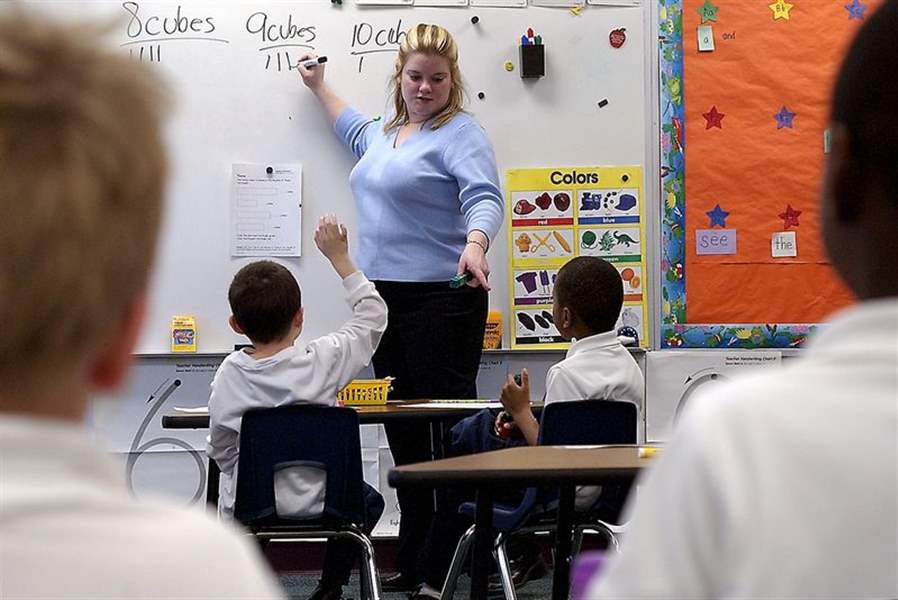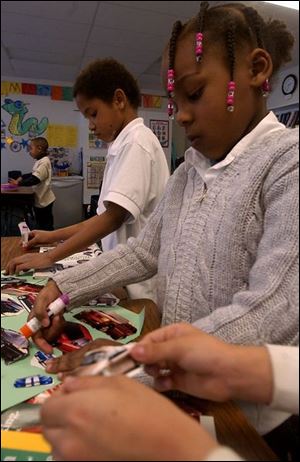
Academies give parents more choices
4/5/2005
Kerri Reamsnyder, a kindergarten teacher at Winterfield Venture Academy on Wenz Road, teaches students to measure.
Nortz / The Blade
Buy This Image

Kerri Reamsnyder, a kindergarten teacher at Winterfield Venture Academy on Wenz Road, teaches students to measure.
Though the effectiveness of charter schools was challenged again last week by another national study, the number of Toledo-area students attending such schools and online academies continues to rise.
More Toledo charter schools are being planned or expanded, while the Toledo Catholic Diocese will be closing three schools and Toledo Public Schools eventually plans to eliminate five schools by the end of its decade-long construction program.
The Economic Policy Institute in Washington, in a report issued Wednesday, found charter schools do not generate higher student achievement than traditional public schools and are not successful at improving the achievement of low-income, minority children.
"I don't think any of us has any doubt there are some terrific charter schools," said Richard Rothstein, a visiting professor at Columbia University's Teachers College who worked on the report. "There are terrific charter schools, and there are terrible charter schools."
Researchers examined test scores for fourth and eighth graders from the National Assessment of Educational Progress and 19 studies of charters in 11 states, including Michigan but not Ohio.

Mercedes Clayborne and Harry Guest, first-grade students at Winterfield Venture Academy, work on an art project during their lesson on transportation.
The study follows an American Federation of Teachers analysis released last summer that showed charter students were half a grade level behind on the National Assessment of Educational Progress.
Tom Baker, superintendent of the Lucas County Educational Service Center, disagreed with some of the latest study's claims and said parents are attracted to different educational choices.
"There are a multitude of reasons why kids choose to go to these schools," he said. "For one, there is a small atmosphere that is not that case in many regular schools."
To operate in Ohio, charter schools will be required by June 30 to have a sponsor, which in turn can collect up to 3 percent of the money the state allocates to the school.
The Lucas County Educational Service Center, with offices near downtown Toledo, sponsors 93 charter schools statewide. The Ohio Council of Community Schools, also in Toledo, sponsors 24 charter schools statewide.
Allison Perz, executive director of the council, said plans for a charter school are scrutinized before it's allowed to open. She said the group rejects more charter schools than it approves.
"Typically, you have people who have very good intentions but have never run a school before or never been involved in a school," Ms. Perz said. "We don't sponsor schools that do not have professional management companies affiliated with them, and we don't sponsor what is typically referred to as a 'mom-and-pop school.'●"
Despite the criticism, 5,336 students living in the Toledo school district had chosen to attend a charter school rather then a regular school as of last month - up from 4,152 during the 2003-04 school year.
"It has had an impact on programs and procedures," said Craig Cotner, chief academic officer for Toledo schools.
Schools like Winterfield Venture Academy, a 350-student charter school at 305 Wenz Rd. that opened in September, have grown in popularity. It offers kindergarten though grade five but plans to add a grade each year until it reaches eight, principal Janice Gigliotti said.
Toledo Public Schools lost $27 million in state student subsidies to charter schools last academic year, and the district predicts it will miss out on $36 million this year.
Though charter school growth has financially hurt TPS, Mr. Cotner said the movement has led the district to sponsor four of its own charter schools and open two single-gender elementary schools as options for parents and students.
State law limits startup charter schools to 225 statewide. That cap is to expire June 30. There are 249 charter schools in Ohio now, attended by about 62,000 of the state's 1.8 million schoolchildren.
Ohio will spend about $400 million this year on charter schools.
Ohio House Speaker Jon Husted (R., Kettering) said last week the state budget would include provisions to slow the growth of charter schools and reduce the impact they have on regular public school systems.
The Marazon Group, which operates Victory Academy, a kindergarten-through-eighth-grade charter school at 3319 Nebraska Ave., plans to open two more Toledo schools: a Great Lakes maritime theme charter school in the fall and a military academy charter school in September, 2006.
"I think as long as the mission of the charter school is unique, it will serve a particular community," said Renee Marazon, president of the operating company. "I don't believe charter schools have been around long enough to get a fair chance."
Critics point to the schools' poor performance as a reason to curb their growth. The 2003-04 Ohio Department of Education school report cards graded 149 charter schools, also called community schools.
Thirty-one percent were listed in academic emergency, 11.5 percent were in academic watch, 29.1 percent were in continuous improvement, 3.4 percent were rated effective, and fewer than 1 percent were excellent.
Charter supporters blame lower test scores at some schools on a higher percentage of students living in poverty.
The Economic Policy Institute study refuted claims made by charter school proponents that more of their students come from poor backgrounds than in traditional schools.
Critics also note that teachers in charter schools are less likely to be fully certified.
About 45 percent only hold long-term substitute credentials. In traditional public schools, more than 95 percent of core-subject classroom teachers are fully certified, according to Ohio Department of Education records.
In addition to the growing popularity of Toledo-area charter schools, online schools, where students attend school from home via the Internet, have flourished in recent years. The Ohio Virtual Academy in Maumee, for example, has 2,500 students statewide in grades kindergarten through eight and plans to add ninth grade in the fall.
Susan Stagner, the academy's head of school, said 28 percent of the students were formerly home-schooled.
This year, 17,300 Ohio students are enrolled in online schools, up from 13,500 last year, and 6,500 during the 2002-2003 school year.
Contact Ignazio Messina at:
imessina@theblade.com
or 419-724-6171.